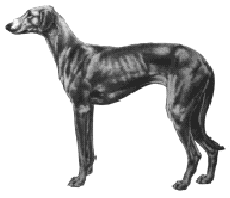Sloughi
General Information - Sloughi

Group:
Hound
Size:
large
Lifespan:
12-14 years
Exercise:
medium
Grooming:
very low
Trainability:
low
Watchdog ability:
high
Protection ability:
low
Area of Origin:
Middle East
Date of Origin:
ancient times
Other Names:
Arabian Greyhound
Original Function:
Hunting desert prey
History
The Sloughi, also known as the Arabian Greyhound, is an ancient sight Hound breed (est. 6000 BC) that shared its life with the nomadic tribes of Africa. This superb hunter and watchdog then spread to North Africa in the Saudi Arabia region where it guarded flocks. Ancient drawings and carvings of this breed have been discovered in tombs. It is a slender-built dog, very similar in structure to the Saluki. It is still a guardian and hunter used by the Bedouins in its homeland of North Africa.
Temperament
The Sloughi is an active dog that is obedient and affectionate with its family, yet wary of strangers.
Upkeep
Daily exercise is essential, preferably in the form of free running in a safe, enclosed area. The Sloughi’s exercise needs can also be met with long leash walks or jogging. Sloughi should sleep inside in all but the warmest climates; they do best as indoor dogs with access to a yard. They can play in snow and cold weather but should not be expected to spend extended time in the cold. The Sloughi must have a soft bed, or it could develop calluses. A Sloughi in proper weight is naturally thin. Many people not familiar with the Sloughi wrongly assume that the dog is not being fed properly. The smooth coat needs only occasional brushing to remove dead hair.
Sloughi
A breed standard is the guideline which describes the ideal characteristics, temperament, and appearance of a breed and ensures that the breed is fit for function with soundness essential. Breeders and judges should at all times be careful to avoid obvious conditions and exaggerations, as well as being mindful of features which could be detrimental in any way to the health, welfare or soundness of this breed.
Breed Standard - Sloughi

GENERAL APPEARANCE: Elegant, racy yet strong without coarseness, square proportions capable of sustained effort over long distances. A dignified hound with fine skin marked by its muscular leanness.
CHARACTERISTICS: Quiet, of dignified bearing. Noble, haughty and loyal with the instinct of a hunting hound.
Temperament: Reserved, aloof with strangers. Neither nervous nor aggressive. Affectionate with family.
Head and skull: Long, refined, an elongated wedge showing strength but not excessively angular. Skull flat, fairly broad. Clearly rounded at back of skull and curving smoothly into sides. Slightly marked frontal bone and pronounced occiput. Muzzle refined without exaggeration, about equal in length to skull. Slight stop. Nose and lips black, may be slightly lighter in dilute colours.
Eyes: Large, dark to dark amber, oval, set slightly obliquely. Expression gentle, rather sad and wistful, eye rims pigmented.
Ears: Flat: not too large, triangular in shape but with rounded tips. Usually folding down and carried close to head, set level with, or slightly above eye but may be carried away from the skull.
Mouth: Jaws strong with a perfect, regular and complete scissor bite, i.e. upper teeth closely overlapping lower teeth and set square to the jaws.
Neck: Strong yet very elegant in proportion to body. Moderately long with good arch. Skin showing fine pleats under throat.
Forequarters: Shoulder blades long and set obliquely onto body. Flat bone and well muscled. Upper arm of moderate length. Pasterns supple and strong.
Body: Chest not broad. Prominent sternum. Slightly sprung ribs giving fairly flat appearance, reaching almost to point of elbow. Reasonably well-ribbed back with definite tuck up. Loin short, broad and muscular, and slightly arched. Topline almost level. Relatively short croup, obliquely set. Pin bones evident.
Hindquarters: Strongly muscled. Fairly flat appearance with moderate angulation, Second thigh long and well-developed. Hocks well let down.
Feet: Lean, elongated oval or hare foot, fairly well arched.
Tail: Fine and well set on without fringes or long hair. Strong curve at end which preferably reaches to point of hock. Set in line with croup as a continuation of topline. When moving never carried higher than level of back.
Gait/movement: Free, smooth, effortless gait, head carriage not too high. Without exaggerated extension.
Coat: Fine and short. Undercoat may grow during winter. No feathering.
Colour: Light to red sand with or without black mask;
Brindle with or without black mask;
Black mantle with sand or brindle points;
Small white mark on chest permissible but undesirable.
Size: Height at withers: dogs 66-72cms (26-28¼ ins); bitches 61-68cms (24-27 ins) encompassing finer desert and heavier mountain types.
Faults: Any departure from the foregoing points should be considered a fault and the seriousness with which the fault should be regarded should be in exact proportion to its degree and its effect upon the health and welfare of the dog and on the dog’s ability to perform its traditional work.
Note:Male animals should have two apparently normal testicles fully descended into the scrotum.
DNZ No 486
Copyright Dogs New Zealand
13 Oct 2022
Any departure from the foregoing points should be considered a fault and the seriousness with which the fault should be regarded should be in exact proportion to its degree and its effect upon the health and welfare of the dog and on the dog’s ability to perform its traditional work.




